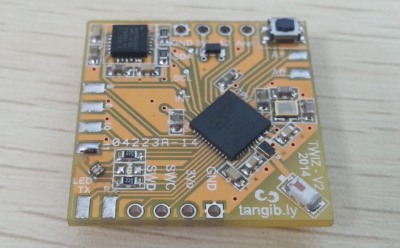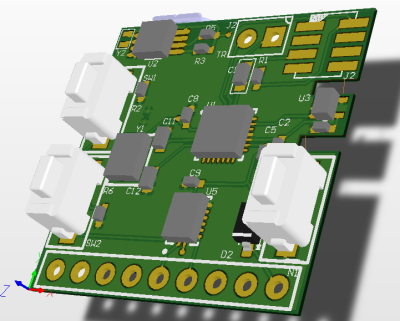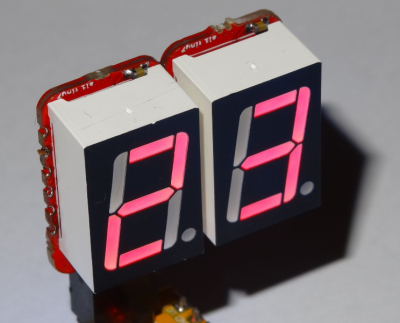 [alpha_ninja] proves that Hackaday.io is not just about great projects, but about an awesome community. Over this past week [alpha_ninja] has created The Square Inch Project, which is a grass-roots contest. The contest rules are pretty simple: The project PCB must fit in a 1″ x 1″ square. That’s 2.54 cm for those that don’t use freedom units. Smaller than a square inch is fine. If the project has multiple PCBs like a cordwood module, ALL the PCBs must still fit within the 1″ x 1″ square. Hackaday.io users coming up with cool contest ideas and inviting everyone to take a shot at winning? Awesome!
[alpha_ninja] proves that Hackaday.io is not just about great projects, but about an awesome community. Over this past week [alpha_ninja] has created The Square Inch Project, which is a grass-roots contest. The contest rules are pretty simple: The project PCB must fit in a 1″ x 1″ square. That’s 2.54 cm for those that don’t use freedom units. Smaller than a square inch is fine. If the project has multiple PCBs like a cordwood module, ALL the PCBs must still fit within the 1″ x 1″ square. Hackaday.io users coming up with cool contest ideas and inviting everyone to take a shot at winning? Awesome!
Of course a contest has to have prizes. [Alpha_ninja] has already lined up $100 in gift certificates to OSHPark. Many thanks to [Laen] and the rest of the OSHPark crew for sponsoring this contest. Hackaday loves the idea so we’re also kicking in eight $50 gift certificates to the Hackaday store, as well as four more $25 gift certificates to OSHPark.
Though the contest has been up for less than a week, the square inch project already has some great entries.
 [Drix] has entered Twiz, a 9 degree of freedom Inertial Measurement Unit (IMU) with Bluetooth Low Energy (BLE) connectivity. Twiz senses its environment with a MPU9150 IMU chip. A nRF51822 provides the Bluetooth connection and ARM Cortex-M0 processor. Put all this together, and you’ve got a great way to determine where an object is in space. [Drix] has used Twiz to control everything from holographic projectors to room lights. Contests aren’t new to [Drix], he’s already entered Twiz in the 2015 Hackaday Prize.
[Drix] has entered Twiz, a 9 degree of freedom Inertial Measurement Unit (IMU) with Bluetooth Low Energy (BLE) connectivity. Twiz senses its environment with a MPU9150 IMU chip. A nRF51822 provides the Bluetooth connection and ARM Cortex-M0 processor. Put all this together, and you’ve got a great way to determine where an object is in space. [Drix] has used Twiz to control everything from holographic projectors to room lights. Contests aren’t new to [Drix], he’s already entered Twiz in the 2015 Hackaday Prize.
 [WeisTekEng] has entered Micro DIY Lipo retro NumiTron clock. [WeisTekEng] loves the classic IV-9 Russian numitron tubes. His plan here is to build a numitron clock driven by an ATmega328 microcontroller. The timebase for this clock is also a classic — The Dallas Semiconductor (now Maxim) DS1307 I2C real-time clock chip. Everything is going to run on a single LiPo cell. Fitting within the project constraints, the board will be only 1″ square. This is [WeisTekEng’s] first big project on Hackaday.io, so we’re happy to see him join the community. He’s also just getting started, so the PCB’s only exist in the virtual word of his EDA software for now. We’re looking forward to reading the numitron clock!
[WeisTekEng] has entered Micro DIY Lipo retro NumiTron clock. [WeisTekEng] loves the classic IV-9 Russian numitron tubes. His plan here is to build a numitron clock driven by an ATmega328 microcontroller. The timebase for this clock is also a classic — The Dallas Semiconductor (now Maxim) DS1307 I2C real-time clock chip. Everything is going to run on a single LiPo cell. Fitting within the project constraints, the board will be only 1″ square. This is [WeisTekEng’s] first big project on Hackaday.io, so we’re happy to see him join the community. He’s also just getting started, so the PCB’s only exist in the virtual word of his EDA software for now. We’re looking forward to reading the numitron clock!
 [Al1] has entered tiny7, a 7 segment display which is compatible with Atmel ISP headers. Ever notice those 6 pin headers on the Arduino? That’s the ISP connector, used to program the ATmega328 micro. In many designs these valuable IO pins spend most of their time unused. [Al1] decided to give them a purpose – displaying data! He’s connected a 75HC595 shift register to the SPI pins of the ISP header. Data clocked into the ‘595 is displayed on a 7 segment display. [Al1] designed the boards with castellated connections on the sides. Some careful soldering allows the boards to be daisy chained. Several 7 segment displays to be driven from a single ISP header.
[Al1] has entered tiny7, a 7 segment display which is compatible with Atmel ISP headers. Ever notice those 6 pin headers on the Arduino? That’s the ISP connector, used to program the ATmega328 micro. In many designs these valuable IO pins spend most of their time unused. [Al1] decided to give them a purpose – displaying data! He’s connected a 75HC595 shift register to the SPI pins of the ISP header. Data clocked into the ‘595 is displayed on a 7 segment display. [Al1] designed the boards with castellated connections on the sides. Some careful soldering allows the boards to be daisy chained. Several 7 segment displays to be driven from a single ISP header.
 [Radomir Dopieralski] is using The Square Inch Project as a learning platform as well. He’s entering Nyan Board, a tiny PCB shaped like everyone’s favorite rainbow pooping cat. [Radomir] is using nyan board to learn how to work with ATtiny microcontrollers. Due to memory constraints, these little controllers can be a bit harder to program than their bigger brothers. [Radomir’s] early goals for Nyan are humble ones – he will be happy to have the cat’s eyes flash while it plays the Nyan Cat tune. Once that task is complete, the RAM and Flash of the ATtiny microcontroller will be his only constraints.
[Radomir Dopieralski] is using The Square Inch Project as a learning platform as well. He’s entering Nyan Board, a tiny PCB shaped like everyone’s favorite rainbow pooping cat. [Radomir] is using nyan board to learn how to work with ATtiny microcontrollers. Due to memory constraints, these little controllers can be a bit harder to program than their bigger brothers. [Radomir’s] early goals for Nyan are humble ones – he will be happy to have the cat’s eyes flash while it plays the Nyan Cat tune. Once that task is complete, the RAM and Flash of the ATtiny microcontroller will be his only constraints.
The contest deadline isn’t until November 28, 2015, so there is still plenty of time to enter. If you want to see more of the entrants, check out The Square Inch Project page, or the entrant list. Want to know more? Ask a question on the project page, or drop [Alpha_Ninja] a message!
That’s it for this week’s Hacklet, As always, see you next week. Same hack time, same hack channel, bringing you the best of Hackaday.io!

















Wow. You call inches “freedom units” huh? I call them retard units. If you’re going to play at being sciencey, perhaps you should use SI derived units like real engineers.
The inch is defined as exactly 25.4 mm since the late 50s. Once you realise US customary units are just an abstraction layer over the real measurement, making it more acceptable to the masses, you understand the attraction of the Arduino platform.
Real engineers use SI and gcc.
Yes, the inch is the Arduino of our times.
In the end, all units are equally arbitrary and abstract. Let’s go back to universal first principles and define our units based on the number of cesium-133 oscillations that take place in the time a photon in a vacuum travels the specified distance…
meter: 30.6633189885 cycles
inch: 1.20721728301 cycles
Oh, now I see! The metric system is MUCH more logical!
So since we can establish that neither system is inherently more “universally correct” than the other, the only advantage of SI is that it’s all base-10. Let me then introduce you to the concept of the decimal inch, which is the standard that built the atom bombs and won the Second World War, and is still used in every American machine shop today.
It’s fine to say that you find one system more convenient than another, but trying to suggest that there’s an objectively superior choice is just stupid. It’s like arguing about which ice cream flavor tastes the best.
n.b.: even base 10 isn’t a universal constant. It’s arbitrarily more useful to us because we have ten fingers. Aliens with four fingers on each hand would undoubtedly use an octal system and find SI tremendously confusing.
It’s not just about the basis of the system, but also the interconversions. Quick, how many fluid ounces in 10 cubic inches?
/thread.
+1
Who cares? It’s 5 seconds of googling to find out.
Ah yes, the imperial system: designed in the 1800s with Google in mind!
But that’s not really how the meter is realised at all – if that were the case, your argument about arbitrariness would stand up.
The realisation of the meter is made by wavelengths in a vacuum. This is independent of timebase; If you wanted to measure time in terms of the average decay of a ham sandwich, an alien with four fingers to a hand would still be able to calculate a meter given the starting point of “Oo12 x element Oo2, Oo1 x element Oo12, excite one into the other, gasseous element Oo65 filter, lambda = 6015430.6061245717
I’m pretty sure I could draw that in a 2.54 x 2.54 mm square.
There are only two advantages to the SI system.
The first is the systematic definition of both absolute and realisable values achievable to great precision and reproducible throughout the understood universe
The second is the prefix’s ability to greatly simplify understanding and to make the same measurement applicable at the smallest limits of matter (one neutrino at 1MeV has a crossection of 20 yoctometers) to the largest (The distance to the cosmic event horizon is about 590 Yottometers)
True, we inherit some things (you note time, which technically isn’t metric but is SI) from combinations of prior culture and the easily observed physical phenomena of their time (I.e. The day, the year, thus the second, the light-year)
AND it’s true this influences the arbritary numbers when we peg values (The speed of light is fixed at 299792458 meters per second – observations of this cannot make it more accurate, we just refine the accuracy of our instruments) but these become levers; ratios to link our understanding of one fundamental (time) to another (space).
Sure, it could be changed to be “neater”. And maybe to Ceasium-second will be adopted; but the ABSOLUTE VALUE of that timeframe will be limited by the accuracy of measurement, not the uncertainty of translation.
However, The U.S. Has changed it’s measurement before. The U.S. Inch used to be 2 millionths of an inch longer than it is now. (And yes, that beats the 0.02% the French were off with their meter by a factor of 10). And it has been your law that the Metric / SI has been legal since 1866, is the preferred system of weights and measurements since before my daughter’s primary school PRINCIPAL was born (1975), and the underpinning to the definition of your system since 1866.
So actually, the meter won the war, the meter built the atomic bomb, and your scientists and engineers (many of whom learnt the metric system as children in Europe or University as adults) did it with the added difficulty of coping with a 2.54 conversion factor, not for cultural reasons, but because it was too late to retrain all the shop workers and all the craftsmen across the country and still have a trading partner at the end of it.
And the decimal inch? It’s two-point-five-four millimetres, by definition. It was in 1933, it was in 1945, and it will still be true in about 40 thousand years when Voyager reaches AC +79 3800 and the local inhabitants try to decipher that golden record.
One inch = 2.54 cm…. not mm….
How about a system that’s used by math and science in pretty much every other country in the world. Not only that, but as is noted below, many of the physicists and other scientists who “built the bomb” grew up with with SI in another country, and then had to work with an ugly conversion factor. The only advantage an inch has here is that it’s single (one of a thing) unit happens to be more convenient for a pcb layout contest than either a square centimeter, or a square decimeter.
https://upload.wikimedia.org/wikipedia/commons/a/ab/Metric_system_adoption_map.svg
All bases are base 10! What is the Nth number in base N? 10!
So a joke about American arrogance is offensive (and it was obviously a joke), but “retard” isn’t?
PCBs are still commonly designed using inches and thousandths of inches. “6/6 trace and space” means 6 thou trace width with minimum 6 thou clearance. Real engineers can use ANY units. See also: https://en.wikipedia.org/wiki/FFF_system
Maybe you should hold off commenting until you learn to recognize a joke.
As an Australian, I have a dislike for stupid imperial measurements just like any other non-American. But seriously, get a grip people – it’s a joke, not a dick; don’t take it so hard!
retard units, lol wow if ur gonna criticize someone for something as petty as cracking a joke, aka (freedom units) why dont u save that energy you used typeing and go jump on a cactus instead,
people like u sir are why tesla never achieved what he truly could.
people like you are why people starve.
you should be ashamed of yourself.
People like you sir, should learn to grow up and learn to spell.
lol it was a damn joke about a joke. it sounds to me like u need to get over yourself everyone in this damn comment section needs to get laid . fuckin nerds
Boom, perfect
*here we go again
I love those “small” (in contrast to HaD prize) contests! Great work, alpha_ninja!
Thank you :)
Er, I think you left the ‘hacklet’ outro on the end of the article.
This is technically Hacklet 78 – The title was too long with the usual numbering system though.
“That’s 2.54 cm for those that don’t use freedom units.” Freedom units? really?
I thought the same thing. Perhaps some kind of a soft dig at metric users. Ultimately futile. The yanks will be using mm and cm sooner than they think. ;-)
I’m not good at jokes, but I think this was one about the fact only Murica uses these units… y’know, murica… freedom…..
Unfortunately even in Europe people are still used to conventional units… how many people do you know that knows how much power they car have in kW? People still use HP.. With the introduction of Electric cars this is changing little by little though..
In most European countries HP is not allowed anymore as a unique indication on products specifications. The watt indication is mandatory, and this rule is in place years before electric car started to be commonly available on the market. The biggest problem is actually dominant old school marketing and journalists that still spread HP value and left in small letters the watt valued if here don’t simply forget to write it.
You are right, the hybrid/electric cars will probably make the HP obsolete more quickly for the future generations.
Murica isn’t free.
It costs $1.06
Wtf? $1.05. Clumsy thumbs for the fail.
‘If you don’t throw in your buck-o-five who will?’
Pretty much all science done in America is done in SI units.
just a failed attempt at giving some reason to why they are using ridiculous measuring units that have no sense at all.
looks like I missed the joke..
Maybe you aren’t old enough to remember when places in the USA started renaming things like French Fries into Freedom Fries. And “Freedom whatever” spawned from that, some very seriously by staunch nationalists, others as laughable jokes and parodies by those who thought it was funny. You read it as a dig at the metric system, I read it as a dig at America for imperialism and a bit of jingoistic tendencies.
Square Inch Project?
Come to the metric side of the force.
let’s create the centimeter square project, a bit more than twice as hard as this one :)
Actually, it’d be 6.4 times as hard.
that’s correct, I ack the mistake
Maybe the “1 cubic cm” project;
Design must fit in either the area of the surface of a 1cm^3 cube /or/ the volume of 1cm^3.
(Surface area of said cube is 6cm^2, make that a square and its… 2.449489742783178 cm x 2.449489742783178 cm …
Round it to 2 significant figures and…
It’s the same prize. Damn. )
Instead of 1cm^3, I suggest the 1dm^3 project. It’s also known as cubesat (also used for high altitude balloons).
(aso, 2.54 != 2.45)
Ack / no edit / thanks
This is how we burn up in the Martian atmosphere.
Although 2.449 and 2.5 and 2.54 are all the same thing at 2 dig figures, which was my point I think.
No rules against free form entry. :P
And my Sunday just got filled…
This is not a centi-inch square, it’s an inch square. Thus, we should have a square meter contest! With blackjack! ;-)
1 meter square PCB can get really expensive. 10cmx10cm on the other hand is a standard size for cheapo Chinese PCB proto PCB, so that’s a good size for a complex design.
But no mounting holes?
I suppose “freedom units” is just an editor joke, imperial units/system is archaic and prone to mistake when communicating with “external” World ;-) Even NASA uses S.I. to avoid mistakes as those faced in the past.
Exactly.
And “imperial” don’t exactly mix with “freedom”, both by definition and from human history observation. Of course this is an editor joke. I just wonder what really the editor expected by using it on a site that promote projects all around the world. Expecting no reaction is depressingly immature. This the kind of joke to make between fiends that share common view, not in a world width community that inevitably includes very incompatible views regarding subject outside the community focus.
Now is the subject is just the unit system, then the editor should post an article on this very subject and let’s debate it. In this case will the editor defend the imperial unity system because it’s a “freedom” unit ? Seriously…
Remember when people in the USA started selling/buying Freedom Fries instead of French Fries?
No? Guess that’s why the joke wooshed by.
US, Burma and Liberia are the countries insist on using the “freedom” units. Does anyone see the irony in this?
Actually that could have been a direct mistranslation of “liberian units” ;-)
Isn’t the metric system a European created and maintained system?
Not really. NIST plays a big part and is fighting to define the definition of weight by fixing the plank value, up against upstart Aussies seeking to fix it against Avagadro’s number.
For the Americans, it’s all in the (Watt) Balance
For the Aussies its about large, smooth carbon balls
That’s 2.54 cm for those that don’t use waterboarding in Guantanamo Bay concentration camp units
Yes, that’s the sort of freedom that we’re promoting.
If you’re a European not speaking German, a simple “Thank you” is all that’s required . . .
What, for funding their side for most of both wars, for refusing to help close allies until your own self interest was involved, or ignoring concentration camps longer than the rest of Europe?
(Doesn’t count when the camps were in your country)
What? No mention of IBM?
Спасибо!
This way we could learn Russian, which is way more better! Oh wait..
Poland, eh? Home of all those great Nazi concentration camps?
Despite the many courageous Poles that fought the Nazis during WWII, I can’t help but wonder if the Germans would have been so efficeint at exterminating Jews, had it not been for the help of the many anti-semite Poles. You got to admit, a 90% kill rate takes some doing.
Absolutely love the freedom units joke! I’m not quite sure why everyone is so butthurt about it though. When PCB layout at 3 different companies as an intern they all used mils and inches. It seems to be the standard as far as PCB work goes.
Yep, that’s the motivation behind the restriction.
Good God. 30 comments so far and only two of them are actually about the content of the article! All the rest are bitching about a simple joke about unit standards.
Here’s a tip: live in the real world. In practice, you’ll get measurements given to you in all sorts of unit systems, and you’re a pretty crappy engineer if that messes you up.
Regarding the actual content of the article: neat idea! Though I wish we saw some more interesting projects coming out of it. Do we really need another tiny IMU? I can buy those on AliExpress for a few bucks each. Yet another nixie tube cloc, ho hum (though I support anyone who is using this project to learn). Anything truly novel and cool?
Regarding the tip; the preferred unit in the U.S. Is metric, by law. Compliance is voluntary. Since 1989. And the U.S. yard has been defined in terms of the metric system since the mid-19th century.
Regarding the competition; it would be better as the “approximately the surface-area-of-1cm^3” but nonetheless it’s great to see community-driven networking within the community.
The preferred freeway speed is 65mph, by law, as well, but that doesn’t mean that anyone actually complies with it.
Defining the US Customary Units (not Imperial!) by metric standards is a good idea that makes conversions 100% accurate. It doesn’t mean that one standard is “better” than the other, or that you should convert all your measurements to that one. Use what you’re comfortable with.
I’m sure, anybody would comply, if it would be 104km/h :-) NO
Even the 130km/h highway speed limits here are often to low to comply “fully”. You have always consider measuring tolerances.
But in PCB design I prefer to use metric units. Modern chips have more and more metric grid (0,5mm or even less).
It was the editor choice to make that joke, not the readers.
Yeah, I thought the Hackaday community had a better sense of humor than this. Self-seriousness doesn’t win any prizes, either. Is everyone hung over or something?
Plus One!
“Freedom Units” – You ROCK!
+1 for the self-deprecating reference to the ridiculousness that was “freedom fries”. Bonus points given the dual nominal association with the french.
No link to al1s board? https://hackaday.io/project/6568-tiny7
Freedom units is a joke folks (for those who weren’t sure). But since we’re on the topic, here’s my favorite quote relating to imperial vs metric:
“In metric, one milliliter of water occupies one cubic centimeter, weighs one gram, and requires one calorie1 of energy to heat up by one degree centigrade — which is 1 percent of the difference between its freezing point and its boiling point. An amount of hydrogen weighing the same amount has exactly one mole of atoms in it. Whereas in the American system, the answer to ‘How much energy does it take to boil a room-temperature gallon of water?’ is ‘Go fuck yourself,’ because you can’t directly relate any of those quantities.” – Wild Thing by Josh Bazell.
I am so stealing that quote.
Wait a minute!
“centigrade” isn’t the official unit for temperature.
“gram” isn’t the official unit for mass.
Sheesh, there are ONLY 7 units in the SI system, and he got 2 wrong.
And “calorie” was deprecated 40 years ago.
Besides, which of the 7 definitions of “calorie” did you mean?
I was fairly sure “calorie” is from the old analogue system, oddly convenient it fits well into metric, the SI is supposed to use Joules I think.
If “gram” isn’t the unit of mass, what is?
Kilogram is the official standard, not the gram. It’s the strange part of the metric system where the SI standard measure has no prefix, except when it does.
Ah, same thing!
the square go-fuck-yourself project.
Fantastic name for a contest. Fantastic sense of humor.
About 1200 BTU? about 150 degrees to increase, and about 8 lb of water (1 floz and 1 oz of water are approximately the same, a gallon is 128 floz and a pound is 8oz. Alternately, a pint and a pound are about the same.), and 1 BTU raises 1 lb of water 1 degF. Not an exact measurement, but a milliliter of water at STP also doesn’t actually weigh a gram (the 1 g/ml definition proved horrendous to try to actually reproduce to use as a definition).
Is that a Freedom gallon or an Imperial gallon?
Nobody specified an altitude either (metric or imperial). Kinda hard to figure out the energy to boil without knowing altitude or I guess more correctly the pressure (in your unit of choose) as you can boil water in an airplane which is pressurized to a different “altitude”
16 ounces a pound the world around, except when a typo makes it 8. Just be glad we aren’t dealing with imperial measurements or that pint would be 20 ounces instead of 16…
1 CM^3 frozen water != 1 CM^3 liquid water.
2.4×2.4 would make more sense owing to the fact that most cheap “proto” board fabs accept sizes of 50x50mm, a 2.4×2.4mm allows 4 to a board with a 1mm gap for hand-scoring between the boards (or mouse-bite routing / v-score if your fab allows).
2.54×2.54mm is very wasteful for most cheap proto fabs, you can only get one on a 50x50mm board.
Dammit give me edit.
s/2\.4×2\.4(mm)?/2.4×2.4cm/
s/2.54×2.54mm/2,54×2,54cm/
You could do 2.4 instead of 2.54 if you want to; the rules just say it has to be smaller, not exactly, one inch square.
The article says: “Smaller than a square inch is fine”
You need Freedom Units to measure your Freedom Fries.
https://en.wikipedia.org/wiki/Freedom_fries
An especially well placed joke since both the units and the fries are associated with France.
Whazzzup, My Glip-Glops. Getting Schwifty in 2013!
Here is some sauce for you to gank some schematics from.
hxxp://arstechnica.com/information-technology/2013/09/microduino-an-arduino-nearly-as-small-as-a-quarter-for-20/
hxxp://www.instructables.com/id/Microduino-a-small-and-stackable-Arduino-Uno/
hxxps://www.tiny-circuits.com/products/tiny-duino.html
hxxps://www.microduino.cc/
“grass roots”
You watched the 2nd EP of Limitless didn’t you. (yes, it was underneath the bumper sticker)
Tumblr/Barrens chat plz go..
I know a cool square inch project: http://vocore.io/wiki/index/id:7
The size of the alpha board is exactly 25.4mm x 25.4mm x 3.6mm
It’s a fully functional wlan router, optional with 2. additional ethernet ports (when using a breadboard)
Very nice! Let’s hope they see this and enter :)
How sad, to use all your massive intellects to down grade what is a great little idea.
Ahhh the bitter autistic humorless horde that is the HAD comment section, jesus fuck lighten up people it’s a joke, nice contest btw.
Yeah, people should chill a bit. Anyway, thank you :)
Looks like a cool contest. My latest project used a board around 1.8in x 2.4in, but it was all through-hole stuff. I was thinking of doing another revision of it, so I’m sure it could be reduced down to the requisite size using surface mount components.
Just a little fuel for the freedom fire: http://www.freedom2measure.org/
2.54cm is too small. My smallest board is 32x32mm. It’s an RGB LED watch with a boatloat of sensors, dedicated precision RTC, USB, lipo charger and fuel gauge, flash storage and Cortex M0+ chip. The only way to reduce that down further would be to go from 4 to 6 layers and use HDI technology (microvia, burried/plugged vias and traces below 0.15mm). I quickly checked how much a proto-board would cost with these technologies, and stopped there because it seems to cost as much as all your prizes combined to get a board with these features prototyped.
Try designing something less complicated, then?
Yes, yes what a great community. So far most of this comment section is people bitching about measuring units…
Two fingers of Scotch, or a four finger lid… It’s all arbitrary, and mostly relative.
That aside, loved the article and the concept implied by the contest.
Those “two fingers” don’t need to be adjacent, do they?
If they merely need to be on that same hand, I select index and pinkie.
If after the first go around you had been down several dollars, play the next round just like
the initially, after which follow next step.